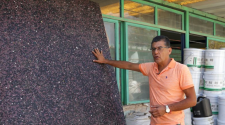By James Temple, via MIT Tech Review
As much as we manage to reduce our carbon dioxide emissions (if we ever do), the greenhouse gas effect can persist for thousands of years. To keep temperatures from reaching dangerous levels, the world will have to remove up to 1 trillion tons of carbon dioxide from the atmosphere in this century, according to the UN IPCC.
But last summer, Harvard University climatologist David Keith discovered that machines could do it, in theory, for less than 88 euros per ton, through a method known as direct air capture. This is an order of magnitude lower than any previous estimate, causing scientists to have discarded the technique as being too expensive (see Numbers fight to decide if capturing carbon from the air is profitable). Although it is also true that there are many years to go before the actual figures come close to Keith's calculations.
Once the carbon is captured, it is still you have to decide what to do with it.
Carbon Engineering, the start-up Canadian co-founded by Keith in 2009, plans to expand its pilot project to increase its synthetic fuel production (watch Canada begins capturing carbon from the air to create neutral fuel). To do this, he plans to use captured carbon dioxide as a key ingredient (Bill Gates is one of Carbon Engineering's investors).
Removing CO2 from the air is one of the difficult ways to deal with climate change, but we are running out of options
Climeworks' direct air capture plant in Italy will produce methane from captured carbon dioxide and hydrogen, while a second plant in Switzerland will sell carbon dioxide to the soft drink industry. Global Thermostat finished building its first commercial factory in the US last year.
Still, whether to make synthetic fuels or in soft drinks, carbon dioxide will return to the atmosphere again. The ultimate goal is to block greenhouse gases forever. Some could be anchored to products like carbon fiber, polymers or concrete, but many more will have to be buried underground - a very expensive approach that no business model seems to support.
In fact, from an engineering perspective, extract CO2 air is one of the most difficult and costly ways to deal with climate change. But given the slowness with which we are reducing emissions, it seems that we have no better options (see “Si queremos gestionar las emisiones, debemos almacenar carbono”).














No Comment